

Leadership That Gets Results. The Idea in Brief Many managers mistakenly assume that leadership style is a function of personality rather than strategic choice.
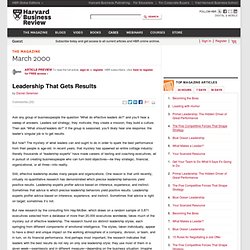
Instead of choosing the one style that suits their temperament, they should ask which style best addresses the demands of a particular situation. Research has shown that the most successful leaders have strengths in the following emotional intelligence competencies: self-awareness, self-regulation, motivation, empathy, and social skill. There are six basic styles of leadership; each makes use of the key components of emotional intelligence in different combinations. The best leaders don’t know just one style of leadership—they’re skilled at several, and have the flexibility to switch between styles as the circumstances dictate. The Idea in Practice Managers often fail to appreciate how profoundly the organizational climate can influence financial results. 1. Collaborative Justice: How to Collaborate. How to Collaborate A Working Definition of the Term “Collaboration” While we all recognize the challenges associated with collaboration, probably the one that receives the least amount of attention is the overuse of the language, and therefore, the misinterpretation of the concept.
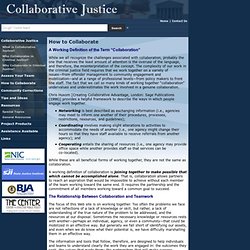
The complexity of our work in the criminal justice field requires that we work together on a variety of issues—from offender management to community engagement and mobilization—and at a range of professional levels—from policy makers to front line staff. Collaboration Demystified: Using Gestalt Synergy to Profitably Do More With Less. The Consultants’ Link Executive Network Presents The Gestalt Leadership Forum Series: Challenges and Solutions W.
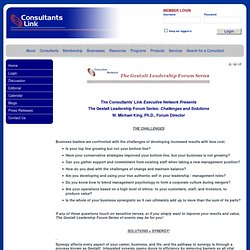
Michael King, Ph.D., Forum Director Business leaders are confronted with the challenges of developing increased results with less cost. Online Learning Management Systems Turbocharge Workforce Performance. Contact us: 800-845-0395 Find out how the latest learning technologies can put workforce productivity in overdrive How can your organization best meet the need for flexible learning at the lowest possible cost?

By utilizing the latest in learning technologies, which incorporate social learning, mobile, and analytics in an easy-to-use, intuitive approach. Improve Collaboration and Cooperation in Your Workplace. How to turn a defensive workplace into a “Green Zone” of success and satisfaction Are you stymied by the collaboration void in your workplace?

Wonder why, when you’ve struggled to hire the best and the brightest, tempers flare and productivity often grinds to a halt? Welcome to Forbes. HOW TO BUILD A COLLABORATIVE WORKPLACE ENVIRONMENT. Details Created on Sunday, 24 March 2013 23:34 Last Updated on Monday, 25 March 2013 00:18 Written by From “Building Collaborative Organizations” by Jim Tamm.

After the patent cliff. 17 Strategies For Improving Collaboration. In a complex business environment where organizations are made up of more and more specialists, a great value is placed on leaders who can bring diverse groups together in a spirit of cooperation to get things done.
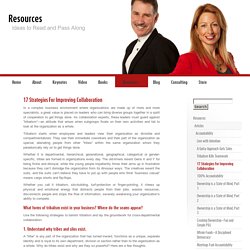
As collaboration experts, these leaders must guard against “tribalism”—an attitude that arises when subgroups fixate on their own activities and fail to look at the organization as a whole. Tribalism starts when employees and leaders view their organization as divisible and compartmentalized. They see their immediate coworkers and their part of the organization as special, alienating people from other “tribes” within the same organization whom they paradoxically rely on to get things done. Whether it is departmental, hierarchical, generational, geographical, categorical or gender-specific, tribes are formed in organizations every day. How to Collaborate: 10 Steps.
A-to-Z strategies for building collaboration. Most leaders agree that effective collaboration is more important than ever in today’s turbulent business environment.
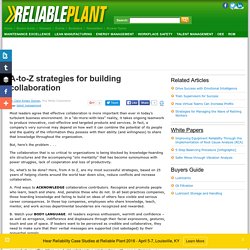
In a “do-more-with-less” reality, it takes ongoing teamwork to produce innovative, cost-effective and targeted products and services. In fact, a company’s very survival may depend on how well it can combine the potential of its people and the quality of the information they possess with their ability (and willingness) to share that knowledge throughout the organization. But, here’s the problem . . . The collaboration that is so critical to organizations is being blocked by knowledge-hoarding silo structures and the accompanying “silo mentality” that has become synonymous with power struggles, lack of cooperation and loss of productivity.
So, what’s to be done? A. B. C. D. E. F. G. H. I. J. K. 6 Ways to Foster Collaboration in Your Workplace. <h1 id="title">6 Ways to Foster Collaboration in Your Workplace</h1><div id="author"><div id="name">Andrew Field</div><div id="title"> </div><div id="bio"></div></div><div id="content"><p>What do the <em>The Avengers, The A Team, The Expendables</em> and<em> X-Men </em>have in common?

How do we get better at collaborating? What we are observing: Collaboration is a sophisticated skill that asks people who work together to look beyond personal interests towards outcomes benefiting the whole.

Collaboration is a great way to address complex challenges, since it has the potential to tap communal creativity and unleash true innovation and earn genuine buy-in. TLC Solutions High Performing Team Model. We are passionate about assisting individuals, teams and organisations to reach high performance. We know that great leadership is an essential component of developing and leading a high performing team. However, it takes more than just great leadership, it takes knowledge and understanding of team and group dynamics and the capacity to utilise this knowledge and understanding to assist a team to reach its true potential. We have developed a model of High Performing Teams based on an analysis of the most relevant and recent research into High Performing Teams, as outlined very simply below.